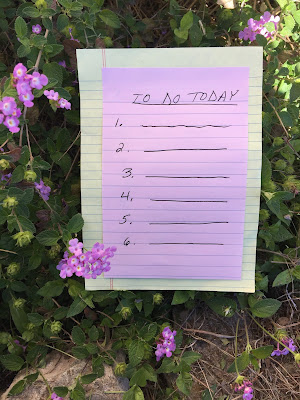 |
| Crazy Weekends! |
Weekend Plan
One of my younger students noticed that her practice handbook indicated that she seldom practiced on the weekends. I asked her about that, and she explained that the schedule was different. She did not have to get up early for school and follow the school day plan. Her parents saved major errands for the weekend, and some of these errands involved long drives. Because my student would be able to spend some lengthy time with her parents on these long drives, my young student accompanied her parents on these trips.
We spent some time thinking about how we could structure things so that she could still practice and still enjoy the unusual schedule and the time spent with her family. We came up with the "weekend plan."
We identified the most important things that she should be practicing. This might vary from student to student. For some students, a set of review pieces could be the most important thing. For this young student, I felt that her new scale and the current piece she was working on qualified as the most important things. But, I recognized that sometimes her pieces to be polished were the most important things.
We made up our very short list. These things probably took about 5 minutes at the most if we were to merely run through them. Five minutes? you ask incredulously. Yes, just five minutes. Remember, my goal was to keep her weekly momentum going and not to derail any progress she had made with her daily practices. In the case of this particular student, her lesson is on Fridays, so the weekend plan was designed to help her get the daily momentum started to carry her through the rest of the week.
Practice Preparation
The next step was to devise a set of simple rules to follow to ensure that her practice plan would be a success. Before going to bed the night before my student planned to use the weekend practice plan, my student got her violin ready to go. She opened up the case and got things put together. All she had to do was wind up the bow. She set out the violin right there so that when she
woke up, it was the first thing she saw.
woke up, it was the first thing she saw.
And here was the one thing that made the whole weekend plan work. She practiced first thing upon waking up. Yes, that was the one thing that saved the day. Before she could get too far into her day, when resisting those impulses to skip practice become so much more insistent, she avoided all of that mental and psychological drama by practicing immediately upon arising when her mind was still getting used to the idea of being awake.
What a lot of folks may not realize is that five minutes is quite a long time. I can accomplish quite a bit of my to do list in 5 minutes. I regularly set a timer in my home for the magic 5 minute window to straighten up a room, clean counter tops, or practice a passage in my Etude book or concerto. My university kids on occasion have 5-minute practice days, when we periodically throughout the day challenge each other to 5 minute intense practice tasks.
Summary
So here is a summary of the weekend plan:
- Plan in advance what the 5-minute practice will consist of
- Prepare the instrument for practice so that it is ready to go with a minimum of fuss and effort
- Put up a sign or other reminder if you need it
- Do it first thing upon waking
- Repeat for every day of the weekend (or other busy schedule period)
And that is all there is to the weekend practice plan. For my young student, she actually liked the weekend plan, and she regularly asked me to come up with more of them. I was delighted to oblige her because I knew that she was getting better practices the rest of the week because she was starting out her week strongly with the daily practice habit.
Until next time,
Happy Practicing!
----- Paula -----
© 2016 by Paula E. Bird






